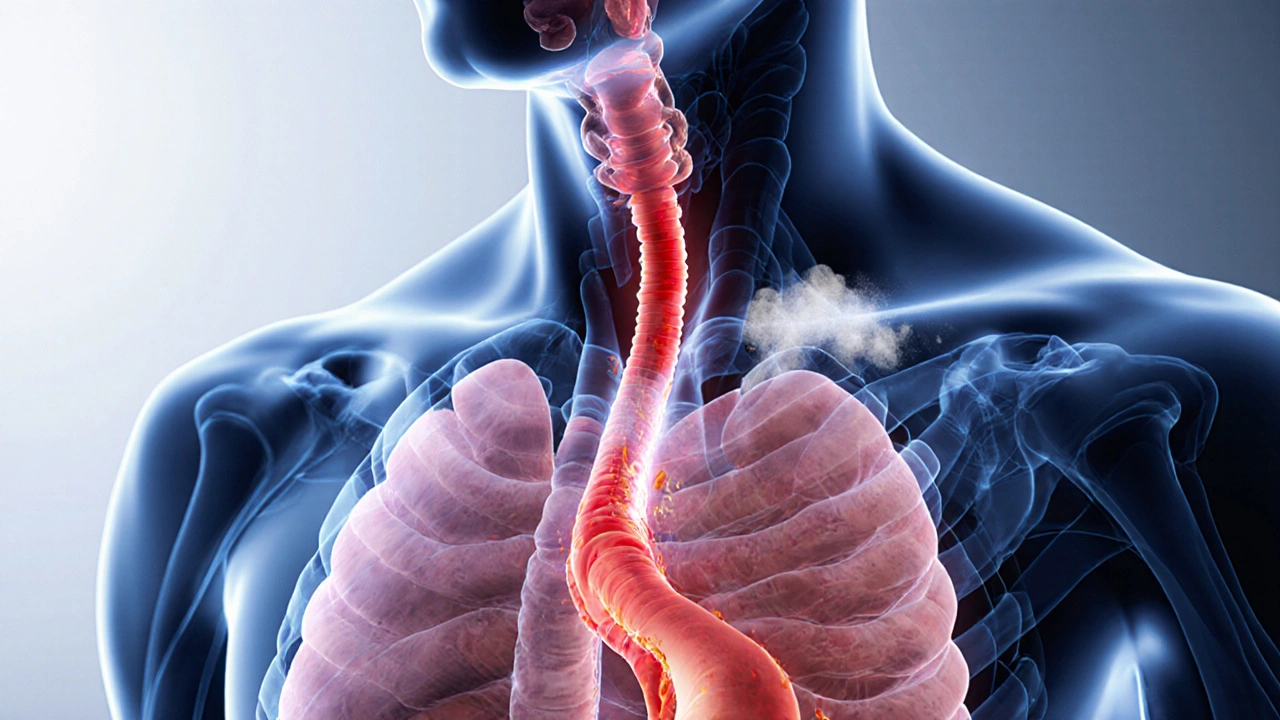Acid Reflux vs Chest Congestion Symptom Checker
This tool helps distinguish between acid reflux and chest congestion symptoms. Answer the following questions about your symptoms to determine which condition is more likely to be the cause.
Symptom Analysis Results
Recommended Actions:
Quick Takeaways
- Stomach acid can travel up the esophagus and irritate the throat, leading to a feeling of chest congestion.
- Typical signs include a persistent cough, rattling in the chest, and a sensation of mucus that won’t clear.
- Lifestyle changes - eating smaller meals, raising the head of the bed, and cutting back on trigger foods - often break the cycle.
- If symptoms last more than two weeks or are accompanied by fever, shortness of breath, or weight loss, see a healthcare professional.
- Medication such as proton‑pump inhibitors or H2 blockers can reduce acid production and relieve congestion.
How Acid Reflux Triggers Chest Congestion
When the lower esophageal sphincter fails to close properly, stomach acid splashes back into the esophagus, it doesn’t stop at the throat. The acid can reach the larynx and even the trachea, a condition doctors call laryngopharyngeal reflux or LPR, where reflux irritates the voice box and airway. That irritation provokes a protective response - a thickened mucus layer and a cough that tries to clear the airway. Over time, the mucus builds up, creating the classic feeling of chest congestion.
The process follows a simple chain of cause and effect:
- Stomach acid rises due to a weak lower esophageal sphincter or a hiatal hernia a slide of the stomach through the diaphragm that compromises the barrier.
- Acid contacts the lining of the esophagus, causing inflammation (esophagitis).
- Inflamed tissue triggers a reflex that spooks the airway nerves, prompting mucus production and a cough.
- Mucus accumulates in the chest, feeling like congestion even without a cold.
Because the airway and the digestive tract share nerve pathways, the brain often misinterprets the signal. That’s why many people think they have a lingering chest infection when the real culprit is reflux.
Key Players: What Each Term Means
Acid reflux is the backward flow of stomach contents into the esophagus, commonly called GERD when chronic. It’s measured by the frequency of heartburn, regurgitation, or throat irritation.
Chest congestion refers to a feeling of tightness, mucus, or rattling in the chest, often linked to respiratory infections but also to reflux.
Stomach acid is primarily hydrochloric acid, essential for digestion but harmful when it contacts the esophageal lining.
Lower esophageal sphincter (LES) acts as a valve between the esophagus and stomach; weakness here is a primary driver of reflux.
Hiatal hernia occurs when part of the stomach pushes through the diaphragm, often weakening LES function.
Chronic cough is a cough lasting longer than eight weeks, frequently caused by reflux‑induced airway irritation.
Postnasal drip is mucus that drips down the back of the throat, a common mimic of reflux‑related congestion.
Asthma can be worsened by reflux, as acid triggers bronchial hyper‑reactivity.

Symptoms Overlap: Spotting the Pattern
Both GERD and chest congestion share a handful of red‑flag signs. The trick is to notice what else appears alongside them.
| Symptom | Typical of GERD | Typical of Chest Congestion |
|---|---|---|
| Heartburn (burning behind sternum) | ✓ | ✗ |
| Regurgitation of sour taste | ✓ | ✗ |
| Persistent dry cough | ✓ (especially at night) | ✓ (often after infection) |
| Rattling or “phlegmy” chest | ✓ (mucus from reflux) | ✓ (mucus from infection) |
| Hoarseness/voice loss | ✓ (acid irritates vocal cords) | ✗ |
| Worsening after meals or lying down | ✓ | ✗ |
Notice that heartburn and sour regurgitation point squarely to reflux, while a fever or colored sputum leans toward an infection. If the cough spikes after a heavy, fatty meal, that’s a strong clue the reflux is at play.
When to Seek Medical Help
Most people can manage mild reflux with diet tweaks, but certain signs demand a professional’s eye:
- Chest pain that mimics a heart attack (tight, radiating, lasting more than a few minutes).
- Unexplained weight loss or loss of appetite.
- Blood in vomit or black, tarry stools - signs of bleeding from esophageal erosion.
- Persistent cough, wheeze, or shortness of breath despite OTC remedies.
- Symptoms lasting longer than two weeks without improvement.
Doctors may order an upper endoscopy, a 24‑hour pH monitoring test, or a chest X‑ray to rule out other conditions. Early detection prevents chronic inflammation that could lead to Barrett’s esophagus or lung scarring.
Lifestyle Tweaks to Break the Cycle
Think of your body as a tiny pressure system. Small adjustments keep the pressure off the LES and stop acid from spilling over.
- Eat smaller, more frequent meals. Large meals stretch the stomach and push acid upward.
- Avoid trigger foods. Common culprits include citrus, chocolate, caffeine, mint, fried foods, and alcohol. Keep a food diary for a week to pinpoint yours.
- Don’t lie down immediately after eating. Wait at least three hours before bed; if you must rest, elevate the head of the bed by 6-8 inches using blocks or a wedge pillow.
- Quit smoking. Nicotine relaxes the LES and increases stomach acid production.
- Maintain a healthy weight. Excess belly fat adds pressure on the abdomen, encouraging reflux.
- Stay hydrated, but avoid gulping large amounts at meals. Water helps dilute acid but should be sipped between bites.
These changes alone often cut the frequency of chest congestion by half within a few weeks.
Medical Treatments That Work
If lifestyle fixes aren’t enough, medication can give the LES a break.
- Proton‑pump inhibitors (PPIs) - drugs like omeprazole or lansoprazole reduce acid production by up to 90%. They’re most effective when taken 30 minutes before breakfast.
- H₂ blockers - such as ranitidine (where available) or famotidine, work faster than PPIs but for a shorter duration.
- Antacids - quick‑acting, over‑the‑counter options (e.g., calcium carbonate) neutralize existing acid and can relieve sudden coughing episodes.
- Prokinetics - medications like metoclopramide improve stomach emptying, reducing the chance of back‑flow.
- Alginate‑based therapy - a foam barrier that sits on top of stomach contents, preventing reflux during the night.
Doctors may combine a PPI with an alginate for night‑time protection, especially in patients who experience morning chest congestion.

Frequently Asked Questions
Can acid reflux cause a true lung infection?
Reflux itself doesn’t introduce bacteria, but the irritation can weaken airway defenses, making a secondary infection more likely if you already have a cold or flu.
Why does my cough get worse when I lie down?
Lying flat lowers the pressure gradient that keeps stomach acid down. Gravity no longer helps, so acid can travel up the esophagus and reach the throat, triggering a cough.
Is a nighttime cough always a sign of reflux?
Not always. Allergies, asthma, or postnasal drip can also cause night‑time coughing. A good rule of thumb is to check for heartburn or a sour taste in the mouth right after the cough.
Can I treat reflux‑related chest congestion without prescription meds?
Yes, many people find relief with dietary changes, weight management, and over‑the‑counter antacids or alginate products. If symptoms persist beyond a month, see a doctor for stronger options.
Do PPIs have long‑term side effects?
Long‑term use (>1 year) may be linked to low magnesium, vitamin B12 deficiency, and a slight increase in bone fracture risk. Talk to your doctor about the shortest effective course.
Understanding the link between acid reflux chest congestion helps you stop the cycle before it becomes chronic. Start with the easy lifestyle tweaks, and if the congestion hangs around, bring a healthcare professional into the loop. Your lungs and throat will thank you.

ADAMA ZAMPOU
October 3, 2025 AT 02:53Understanding the mechanistic cascade from lower esophageal sphincter incompetence to laryngeal irritation elucidates why patients often mistake reflux‑induced mucus for a classic respiratory infection. When gastric contents ascend, they interact with the supraglottic mucosa, stimulating vagal afferents that precipitate hypersecretory mucus production and a protective cough reflex. This physiologic loop explains the nocturnal exacerbation commonly reported in clinical histories.
Liam McDonald
October 7, 2025 AT 00:29I’ve seen many folks struggle with that nightly cough and the feeling of stuffiness in the chest; the good news is that modest lifestyle tweaks often make a big difference.
Adam Khan
October 10, 2025 AT 22:05From a gastroenterological perspective, the etiopathogenesis of reflux‑related chest congestion can be parsed into discrete, interrelated domains. First, the anatomical integrity of the lower esophageal sphincter (LES) determines the pressure gradient across the gastro‑oesophageal junction; a compromised LES permits retrograde flow of acidic chyme into the distal esophagus. Second, the presence of a hiatal hernia further attenuates sphincteric competence by altering diaphragmatic anchorage, thereby facilitating intermittent leaks. Third, the physicochemical properties of gastric secretions-principally hydrochloric acid, pepsin, and bile salts-exert a corrosive effect on the esophageal epithelium, inciting erosive esophagitis. Fourth, the neurogenic reflex arc, mediated by afferent fibers of the vagus nerve, transduces esophageal irritation into bronchial hyper‑reactivity, prompting mucous hypersecretion and cough. Fifth, the resultant mucus accumulates in the proximal airway, manifesting as the sensation of chest congestion that mimics infectious etiologies. Empirical data from pH‑impedance monitoring studies demonstrate that episodes of acid exposure correlate temporally with spikes in cough frequency, establishing a causal linkage. Pharmacologically, proton‑pump inhibitors (PPIs) achieve up to a ninety percent reduction in gastric acid output by irreversible inhibition of the H⁺/K⁺‑ATPase pump, thereby mitigating mucosal injury. However, PPIs do not address impaired LES tone; adjunctive agents such as alginate‑based formulations create a buoyant raft that physically blocks reflux during recumbency. Lifestyle interventions-weight reduction, avoidance of trigger foods, and head‑of‑bed elevation-remain cornerstone measures that modulate intra‑abdominal pressure and reduce reflux propensity. Moreover, the role of dysmotility cannot be overlooked; prokinetic agents like metoclopramide enhance gastric emptying, shortening the window during which reflux can occur. In refractory cases, surgical options such as laparoscopic fundoplication restore LES competence through circumferential wrap creation, offering durable symptom control. It is also imperative to differentiate reflux‑induced cough from asthma or post‑nasal drip, as misdiagnosis can lead to inappropriate inhaled corticosteroid use. Finally, long‑term reliance on high‑dose PPIs warrants surveillance for potential adverse effects, including hypomagnesemia, vitamin B₁₂ deficiency, and altered gut microbiota composition. Continued research into esophageal‑baseline motility patterns promises to refine personalized therapeutic algorithms.
rishabh ostwal
October 14, 2025 AT 19:41While the mechanistic exposition is exhaustive, it overlooks the psychosomatic dimension wherein anxiety amplifies perception of chest tightness, thereby confounding pure physiological attribution.
Kristen Woods
October 18, 2025 AT 17:17I swear I tried every “miracle” diet on the internet, from grapefruit fasting to charcoal detox, and still woke up choking on my own spit; the only thing that finally silenced the night‑time rattle was buying a wedge pillow and finally admitting that my “acid problem” was actually my stubbornness to change.
Carlos A Colón
October 22, 2025 AT 14:53Oh great, another miracle cure that costs more than my rent.
Aurora Morealis
October 26, 2025 AT 12:29Use a food diary track triggers note patterns improve sleep quality
Sara Blanchard
October 30, 2025 AT 10:05Remember that cultural dietary habits can influence reflux triggers, so consider adapting traditional recipes by reducing fried components and incorporating more fiber‑rich vegetables; sharing these adjustments with family can foster a supportive environment for everyone’s health.
Anthony Palmowski
November 3, 2025 AT 07:41Honestly, your anecdotal “miracle” saga is a textbook example of why anecdotal evidence should be discarded!!! Evidence‑based protocols exist for a reason; stop glorifying trial‑and‑error nonsense!!!
Jillian Rooney
November 7, 2025 AT 05:17i guess if u keep ignoring the med advice maybe u get better but probably not
Rex Peterson
November 11, 2025 AT 02:53The interplay between gastro‑esophageal physiology and respiratory symptomatology invites a broader contemplation of bodily integration, wherein no organ operates in isolation. When the stomach’s acidic milieu breaches its intended confinements, it not only disrupts digestive homeostasis but also co‑opts the airway’s protective mechanisms, exemplifying a systemic ripple effect. Such interdependence challenges the reductionist view that compartmentalizes ailments, urging clinicians to adopt a holistic diagnostic lens. Moreover, the temporal correlation of nocturnal reflux with sleep architecture disturbances underscores the bidirectional relationship between physiological stressors and restorative processes. In philosophical terms, the body can be seen as an intricate network of feedback loops, each modulation echoing through the whole. Recognizing this, therapeutic strategies must transcend mere symptom suppression and aim to recalibrate the underlying equilibria-through dietary stewardship, positional therapy, and judicious pharmacology. The ethical dimension arises when long‑term pharmacologic suppression is weighed against potential adverse sequelae, compelling practitioners to engage patients in shared decision‑making. Furthermore, the sociocultural context, encompassing dietary customs and health literacy, modulates both perception and management of reflux, reminding us that medicine is as cultural as it is scientific. As research advances, novel biomarkers of esophageal exposure may permit individualized interventions, aligning with the principle of precision medicine. Until such tools are commonplace, the prudent clinician must rely on meticulous history‑taking, objective testing where indicated, and empathetic patient education. By honoring the interconnectedness of organ systems, we not only alleviate chest congestion but also reinforce the broader pursuit of holistic well‑being.